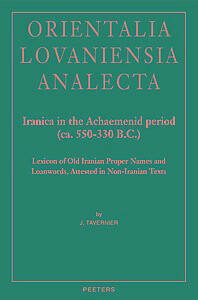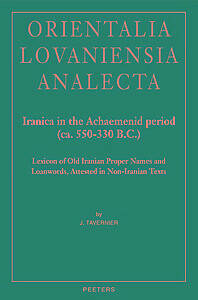
Je cadeautjes zeker op tijd in huis hebben voor de feestdagen? Kom langs in onze winkels en vind het perfecte geschenk!
- Afhalen na 1 uur in een winkel met voorraad
- Gratis thuislevering in België vanaf € 30
- Ruim aanbod met 7 miljoen producten
Je cadeautjes zeker op tijd in huis hebben voor de feestdagen? Kom langs in onze winkels en vind het perfecte geschenk!
- Afhalen na 1 uur in een winkel met voorraad
- Gratis thuislevering in België vanaf € 30
- Ruim aanbod met 7 miljoen producten
Zoeken
Iranica in the Achaemenid Period (Ca. 550-330 B.C.)
Lexicon of Old Iranian Proper Names and Loanwords, Attested in Non-Iranian Texts
J Tavernier
€ 208,95
+ 417 punten
Omschrijving
This book collects and discusses the Old Iranian divine names, personal names, geographical names (toponyms, hydronyms and oronyms) and loanwords, which are attested in texts written in Aramaic, Babylonian, Egyptian, Elamite, Lycian, Lydian and Phrygian. The texts, both royal inscriptions and documentary texts, are discovered in the entire territory of the Achaemenid Empire (from Egypt to Bactria), which controlled the Ancient Near East from ca. 550 to 331 B.C. The Iranica discussed in this book are divided into four categories: (1) directly transmitted Iranica, (2) semi-directly transmitted Iranica, (3) foreign Iranica and (4) indirectly transmitted Iranica (the so-called "Altiranische Nebenuberlieferung"). All expressions, which do not belong to one of these categories, are brought together in a section called "Incerta". The etymology and linguistic setting of each Iranian expression is studied and a list of occurrences is added to this analysis.
Specificaties
Betrokkenen
- Auteur(s):
- Uitgeverij:
Inhoud
- Aantal bladzijden:
- 850
- Taal:
- Engels
- Reeks:
- Reeksnummer:
- nr. 158
Eigenschappen
- Productcode (EAN):
- 9789042918337
- Verschijningsdatum:
- 23/05/2007
- Uitvoering:
- Hardcover
- Formaat:
- Genaaid
- Afmetingen:
- 172 mm x 244 mm
- Gewicht:
- 1737 g

Alleen bij Standaard Boekhandel
+ 417 punten op je klantenkaart van Standaard Boekhandel
Beoordelingen
We publiceren alleen reviews die voldoen aan de voorwaarden voor reviews. Bekijk onze voorwaarden voor reviews.









